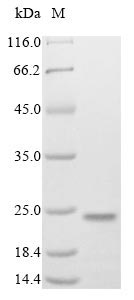Recombinant Mouse Transcription factor MafK is expressed in a mammalian cell system, which appears to ensure proper folding and post-translational modifications. The protein comes as a full-length construct covering amino acids 1-156. It includes an N-terminal 10xHis tag and a C-terminal Myc tag for purification and detection purposes. SDS-PAGE analysis shows purity exceeds 85%, making it suitable for various research applications.
MafK belongs to the small Maf transcription factor family and is known for forming heterodimers with larger basic leucine zipper proteins. The protein likely plays a role in regulating gene expression by binding to DNA and influencing pathways such as oxidative stress response and cellular differentiation. Given its function in transcriptional regulation, MafK represents an important target for studies examining gene expression and cellular processes.
Potential Applications
Note: The applications listed below are based on what we know about this protein's biological functions, published research, and experience from experts in the field. However, we haven't fully tested all of these applications ourselves yet. We'd recommend running some preliminary tests first to make sure they work for your specific research goals.
Mouse Transcription factor MafK is a basic leucine zipper (bZIP) protein that requires precise dimerization and DNA-binding domain folding for its transcriptional regulatory activity. The mammalian cell expression system provides the optimal eukaryotic environment for proper folding, post-translational modifications, and dimerization. However, the dual N-terminal His-tag and C-terminal Myc-tag may sterically interfere with the bZIP domain's dimerization interface or DNA-binding activity. While mammalian expression increases the probability of correct folding, the terminal tags require experimental validation to confirm functional activity.
1. Protein-Protein Interaction Studies Using Pull-Down Assays
Transcription factor interactions require precise tertiary and quaternary structures that must be confirmed.
If Correctly Folded (Verified): Highly suitable for identifying physiological binding partners (e.g., other bZIP proteins, co-regulators) with high confidence in results.
If Misfolded/Unverified: High risk of non-specific binding or failure to interact; may produce biologically misleading data.
2. Antibody Development and Validation
Antibody development benefits from correct folding but can proceed based on sequence.
If Correctly Folded (Verified): Excellent for generating conformation-sensitive antibodies that recognize native MafK epitopes.
If Misfolded/Unverified: Suitable for producing antibodies against linear epitopes only; may not recognize native protein structure.
3. ELISA-Based Quantitative Assays
Immunoassays primarily rely on sequence recognition rather than functional conformation.
If Correctly Folded (Verified): Ideal as a quantitative standard for accurately measuring native MafK levels in biological samples.
If Misfolded/Unverified: Suitable as an immunoassay standard but may not reflect functional transcription factor levels.
4. Biochemical Characterization and Stability Studies
These studies are critical for determining the protein's quality and functional status.
If Correctly Folded (Verified): Essential for validating dimerization state, DNA-binding capacity, and thermal stability.
If Misfolded/Unverified: Still valuable for assessing physical properties, but characterizes non-native protein.
Final Recommendation & Action Plan
The mammalian expression system provides a high probability of correct folding for this transcription factor, but the dual terminal tags require experimental validation before reliable use in functional studies. The immediate priority is Application 4 (Biochemical Characterization) to assess dimerization state via size-exclusion chromatography with multi-angle light scattering (SEC-MALS) and validate DNA-binding activity through electrophoretic mobility shift assays (EMSA). If correct folding and DNA-binding activity are verified, proceed confidently with Applications 1, 2 (conformational antibodies), and 3 for interaction studies, antibody development, and quantitative assays. If misfolding is detected, limit applications to linear epitope antibody production (Application 2) and use as an immunoassay standard (Application 3). For all functional applications, include appropriate controls and consider tag removal if the tags interfere with activity. This systematic approach ensures appropriate use based on experimental validation of protein folding and functional competence.






